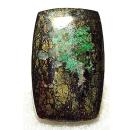|
|
||||||||||||||||
|
||||||||||||||||
|
||||||
|
|
|
|
Chalcopyrite
|
|
| | |
| Discovered in 1747; IMA status: Valid (pre-IMA; Grandfathered) | ||
|
| ||
|
Chemistry |
|
|
| |
|
CuFeS2 | |
|
|
Copper Iron Sulfide |
|
Molecular Weight: |
521.21 gm |
|
Composition: |
Iron |
30.43 % |
Fe |
|
|
|
|
Copper |
34.63 % |
Cu |
|
|
|
|
Sulfur |
34.94 % |
S |
|
|
|
|
|
100.00 % |
|
|
|
|
|
|
||||
|
Classification |
|
|
| |
|
Sulfides | |
|
2/C.03-10 | |
|
|
2 : SULFIDES and SULFOSALTS (sulfides, selenides, tellurides;
arsenides, antimonides, bismuthides; sulfarsenites, sulfantimonites,
sulfbismuthites, etc.) |
|
Related to: |
Chalcopyrite Group. Chalcopyrite - Eskebornite Series. |
|
Members of Group: |
Chalcopyrite Group: Chalcopyrite, Eskebornite, Gallite, Laforκtite, Lenaite, Roquesite |
|
Varieties: |
Auriferous Chalcopyrite, Blister Copper, Stannian Chalcopyrite |
|
Synonyms: |
Chalkopyrite, Copper Pyrites, Cupropyrite, Gelferz, Kopparglasertz, Kupfereisenerz, Kupfereisenerzkies, Kupferkis, Towanite, Yellow Copper, Yellow Copper Ore, Yellow Pyrite |
|
|
|
|
Crystal Data |
|
|
|
|
|
Equant, tetrahedral-shaped crystals, may be modified by scalenohedral faces, to as large as 10 cm. Sphenoidal faces typically large, dull in luster and striated. Commonly massive, compact; can be botryoidal. |
|
|
Twin plane {112}, composition surface commonly {112}; twin plane {012}; also by rotation about {001} with composition plane {110}, producing penetration twins. |
|
|
|
|
|
Physical Properties |
|
|
|
|
|
Poor/Indistinct on {011}, Poor/Indistinct on {111} |
|
|
Irregular/Uneven |
|
|
Brittle |
|
|
3.5 - 4.0 |
|
|
4.1 - 4.3 (g/cm3) |
|
|
None |
|
|
Not Radioactive |
|
|
Other: |
Magnetic after heating. |
|
|
|
|
Optical Properties |
|
|
|
|
|
Brass Yellow, honey Yellow; may be tarnished and iridescent |
|
|
Opaque |
|
|
Metallic |
|
|
R1R2: (400) 16.017.3, (420) 20.021.3, (440) 24.826.1, (460) 30.231.4, (480) 34.935.9, (500) 38.939.9, (520) 41.942.7, (540) 44.044.9, (560) 45.446.4, (580) 46.647.6, (600) 47.148.3, (620) 47.54.86, (640) 47.648.7, (660) 47.648.7, (680) 47.648.6, (700) 47.648.6 |
|
|
None; Opaque |
|
|
None |
|
|
None |
|
|
Weak |
|
|
|
|
|
Occurances |
|
|
|
|
|
Geological Setting: |
A primary mineral in hydrothermal veins, stockworks, disseminations, and massive replacements; an exsolution product in mafic igneous rocks; of sedimentary origin controlled by redox conditions. |
|
Common Associations: |
Galena, Pyrite, Sphalerite, Tetrahedrite, many Copper Sulfides |
|
Common Impurities: |
Ag, Au, In, Tl, Se, Te |
|
Type Locality: |
Unknown |
|
Year Discovered: |
1747 |
|
View mineral photos: | |
|
|
|
|
More Information |
|
|
|
|
|
| |
|
|
|
|
Chalcopyrite
is found in many localities worldwide. Notable occurances
include Rouyn district, Quebec, Canada; Huaron, Peru;
the Nababiep
Mine, Cape Province, South Africa; and Bisbee,
Cochise County, Arizona, USA. |
|
|
We
have not photographed our Chalcopyrite gems. Please
check back soon. |
